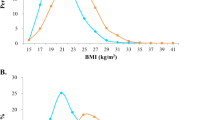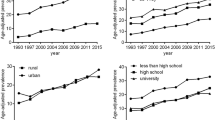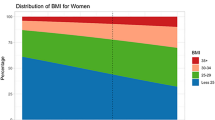Abstract
We analyzed the obesity trends in Hong Kong using data from a health assessment program. We recruited 84 357 subjects (27 452 men and 56 905 women; age: mean±s.d. 49.0±14.7 years, range 20–98 years) in three phases: (1) April 1996 to August 1997 (n=17 119); (2) February 2001 to December 2002 (n=16 978); and (3) January 2004 to December 2005 (n=50 260). Waist circumferences were available only in phases 2 and 3. Central obesity was defined as waist ⩾90 cm in men and ⩾80 cm in women. Overweight and obesity (general) were defined as body mass index (BMI) ⩾23 and ⩾25 kg/m2, respectively. The age-standardized rate (95% CI) of general obesity was stable in men (31.6% (29.6, 33.7) in 1996 vs 31.0% (30.0, 32.0) in 2005, P: NS) but declined in women (22.4% (21.3, 23.5) in 1996 vs 18.8% (18.2, 19.4) in 2005, P<0.05). The prevalence of central obesity increased from 23.0% (20.6, 25.4) in 2001 to 26.9% (26.0, 27.8) in 2005 in men (P<0.05) and remained stable in women, with corresponding rates of 27.5% (25.8, 29.3) and 26.6% (26.0, 27.3), respectively (P: NS). In summary, despite stable or declining BMI, age-standardized central obesity failed to decline in Hong Kong Chinese women and continued to increase in Chinese men over a 10-year period.
This is a preview of subscription content, access via your institution
Access options
Subscribe to this journal
Receive 12 print issues and online access
$259.00 per year
only $21.58 per issue
Buy this article
- Purchase on Springer Link
- Instant access to full article PDF
Prices may be subject to local taxes which are calculated during checkout

Similar content being viewed by others
References
Adams KF, Schatzkin A, Harris TB, Kipnis V, Mouw T, Ballard-Barbash R et al. (2006). Overweight, obesity, and mortality in a large prospective cohort of persons 50 to 71 years old. N Engl J Med 355, 763–778.
APCSC (2007). Asia Pacific Cohort Studies Collaboration (APCSC): the burden of overweight and obesity in the Asia-Pacific region. Obes Rev 8, 191–196.
Cheung BM, Wat NM, Tam S, Thomas GN, Leung GM, Cheng CH et al. (2008). Components of the metabolic syndrome predictive of its development: a 6-year longitudinal study in Hong Kong Chinese. Clin Endocrinol (Oxf) 68, 730–737.
Hospital-Authority. Hong Kong population age and sex structure 2005. Hospital Authority Statistical Report 2005/2006. Authority-H: Hong Kong, 2006.
Huxley R, James WP, Barzi F, Patel JV, Lear SA, Suriyawongpaisal P et al. (2008). Ethnic comparisons of the cross-sectional relationships between measures of body size with diabetes and hypertension. Obes Rev 9 (Suppl 1), 53–61.
IOTF. International Obesity Task Force (IOTF) prevalence data: global obesity prevalence in adults. vol 2009. 2009: http://www.iotf.org/database/index.asp.
Ko GT, Tang JS (2006). Prevalence of obesity, overweight and underweight in a Hong Kong community: the United Christian Nethersole Community Health Service (UCNCHS) primary health care program 1996-1997. Asia Pacific J Clin Nutr 15, 236–241.
Ko GT, Tang JS (2007). Waist circumference and BMI cut-off based on 10-year cardiovascular risk: evidence for ‘central pre-obesity’. Obesity (Silver Spring) 15, 2832–2839.
Misra A, Vikram NK (2003). Clinical and pathophysiological consequences of abdominal adiposity and abdominal adipose tissue depots. Nutrition 19, 457–466.
Ning F, Pang ZC, Dong YH, Gao WG, Nan HR, Wang SJ et al. (2009). Risk factors associated with the dramatic increase in the prevalence of diabetes in the adult Chinese population in Qingdao, China. Diabet Med 26, 855–863.
WHO (2004). WHO expert consultation: appropriate body-mass index for Asian populations and its implications for policy and intervention strategies. Lancet 363, 157–163.
WHO/IASO/IOTF (2000). The Asia-Pacific Perspective: Redefining Obesity and Its Treatment. Health Communications Australia: Melbourne.
Author information
Authors and Affiliations
Corresponding author
Ethics declarations
Competing interests
The authors declare no conflict of interest.
Rights and permissions
About this article
Cite this article
Ko, G., Tang, J. & Chan, J. Worsening trend of central obesity despite stable or declining body mass index in Hong Kong Chinese between 1996 and 2005. Eur J Clin Nutr 64, 549–552 (2010). https://doi.org/10.1038/ejcn.2010.49
Received:
Revised:
Accepted:
Published:
Issue Date:
DOI: https://doi.org/10.1038/ejcn.2010.49
Keywords
This article is cited by
-
Secular trends in all-cause and cause-specific mortality rates in people with diabetes in Hong Kong, 2001–2016: a retrospective cohort study
Diabetologia (2020)
-
Increases in waist circumference independent of weight in Mongolia over the last decade: the Mongolian STEPS surveys
BMC Obesity (2017)
-
Estimating the proportion of metabolic health outcomes attributable to obesity: a cross-sectional exploration of body mass index and waist circumference combinations
BMC Obesity (2016)
-
Abdominal vs. overall obesity among women in a nutrition transition context: geographic and socio-economic patterns of abdominal-only obesity in Tunisia
Population Health Metrics (2015)
-
The diminishing socioeconomic disparity in obesity in a Chinese population with rapid economic development: analysis of serial cross-sectional health survey data 2002–2010
BMC Public Health (2015)



